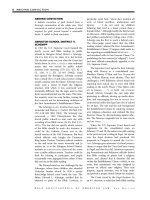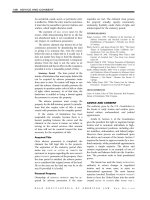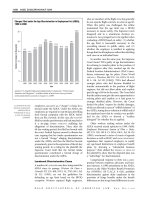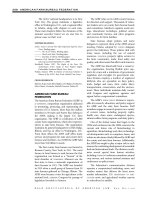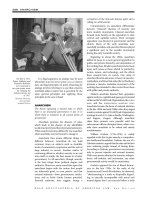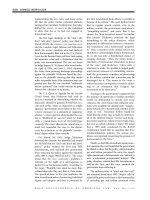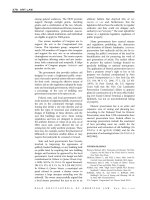Gale Encyclopedia Of American Law 3Rd Edition Volume 3 P3 ppt
Bạn đang xem bản rút gọn của tài liệu. Xem và tải ngay bản đầy đủ của tài liệu tại đây (197.56 KB, 10 trang )
broadcasting involving intrastate activity may be
subject to local taxation.
A state may impose a nondiscriminatory tax
for the use of its highways by motor vehicles
in interstate commerce if the charge bears a
fair relation to the cost of the construction,
maintenance, and regulation of its highways.
The commerce clause does not prohibit a
state from imposing a tax on a natural resource
that is produced within its borders and that is
sold primarily to residents of other states. In
Commonwealth Edison Co. v. Montana, 453 U.S.
609, 101 S. Ct. 2946, 69 L. Ed. 2d 884 (1981),
the U.S. Supreme Court upheld a 30 percent
SEVERANCE tax levied by Montana on the
production of coal, the bulk of which was
exported for sale to other states. The amount of
the tax was challenged as an unconstitutional
burden on interstate commerce. The Court
reasoned that the commerce clause does not
give the residents of one state the right to obtain
resources from another state at what they
consider a reasonable price, for that right would
enable one state to control the development and
depletion of natural resources in another state.
If that right were recognized, state and federal
courts would be forced to formulate and to
apply a test for determining what is a reasonable
rate of taxation on legitimate subjects of
taxation, tasks that rightfully belong to the
legislature.
In 2005 the Supreme Court reviewed the
imposition of a motor vehicle fee by the State of
Michigan. Under the Michigan law, motor
carriers were required to pay a flat fee of $100
for a permit to transport property withi n the
state. This fee applied both to motor carriers
that limit their operations in the state and to
those that engaged in both interstate and
intrastate operations. The fee did not depend
upon the number of miles traveled within the
state, the number of trips taken within the state,
or the portion of the time that a carrier spent
traveling between states or within states other
than Michigan. The MCA requires payment
of other fees as well. The statute requires all
carriers that are registered in Michigan and that
operate exclusively in interstate commerce to
pay a $100 fee. Additionally, all motor carriers
that are registered outside the state must pay
a registration fee of $10.
In an opinion by Justice
STEPHEN G. BREYER,
the majority concluded that nothing in the
Michigan statute offended the commerce clause
because the fee only affected activities taking
place within the borders of the state of Michigan.
Moreover, the Court rejected arguments that
the state imposed the fee in a manner that
burdened interstate commerce (American Truck-
ing Ass’ns v. Michigan Public Serv. Commission,
545 U.S. 429, 125 S. Ct. 2419, 162 L. Ed. 2d 407
[2005]).
In a 2008 decision the Court ruled that
the commonwealth of Kentucky could exempt
its residents from payin g tax on the interest
of municipal
BONDS issued by the common-
wealth and its cities, counties, and other
political subdivisions, while taxing them for
interest on municipal b onds issu ed by oth er
states (Department of Revenue of K entucky v.
Davis, ___ U.S. ___, 128 S. Ct. 1801, 1 70 L.
Ed. 2d 6 85 [2008]). The Court determined that
this long-standing practice was justified in
ways that did not implicate the commerce
clause.
Crimes Involving Commerce
Congress may punish any conduct that inter-
feres with, obstructs, or prevents interstate and
foreign commerce, whether it occurs within one
state or involves a number of states. The
MANN
ACT
, which outlaws the transportation of any
woman or girl in interstate or foreign commerce
for the purpose of
PROSTITUTION, debauchery, or
other immoral acts, is a constitutional exercise
of the power of Congress to regulate commerce
(18 U.S.C.A. §§ 2421-2424 [1910]). The
COUN-
TERFEITING
of notes of foreign corporations and
bills of lading is a crime against interstate
commerce. Under federal statutes, the knowing
use of a
COMMON CARRIER for the transportation
of
OBSCENE matter in interstate or foreign
commerce for the purpose of its sale or
distribution is illegal. This prohibition applies
to the importation of obscene matter even
though it is for the importer’s private, personal
use and possession and not for commercial
purposes.
The Anti-Racketeering Act (18 U.S.C.A.
§ 1951 [2000]) makes
RACKETEERING by ROBBERY
or per sonal violence that interferes with inter-
state commerce a federal offense. The provi-
sions of the
CONSUMER CREDIT PROTECTION ACT
(15 U.S.C.A. § 1601 et seq. [2000]) prohibiting
EXTORTION have been upheld, as extortion is
deemed to impose an undue burden on
GALE ENCYCLOPEDIA OF AMERICAN LAW, 3RD E DITION
8 COMMERCE CLAUSE
interstate commerce. Anyone who transports
stolen goods of the value of $5,000 or more in
interstate or foreign commerce is subject to
criminal prosecution pursuant to the National
Stolen Property Act (18 U.S.C.A. § 2311 et seq.
[2000]).
FURTHER READINGS
Cauthorn, Kim. 1995. “Supreme Court Interprets Scope of
Congressional Authority under Interstate Commerce
Clause.” Houston Lawyer 33-AUG (July-August).
Conant, Michael. 2008. The Constitution and Economic
Regulation: Objective Theory and Critical Commentary.
New Brunswick, N.J.: Transaction.
McJohn, Stephen M. 1995. “The Impact of United States v.
Lopez: The New Hybrid Commerce Clause.” Duquesne
Law Review 34.
Prentice, E. Parmalee, and John G. Egan. The Commerce
Clause of the Federal Constitution. Littleton, Colo.: F. B.
Rothman.
Ramaswamy, M. 1948. The Commerce Clause in the Con-
stitution of the United States. New York: Longmans,
Green.
Weaver, Russell L. 2009. Inside Constitutional Law: What
Matters and Why. New York: Aspen.
CROSS REFERENCES
Civil Rights; Federalism; Interstate Commerce Commission;
Preemption; States’ Rights; Telecommunications.
COMMERCE DEPARTMENT
The DEPARTMENT OF COMMERCE (DOC) is an
agency of the
EXECUTIVE BRANCH of the federal
government that promotes international trade,
economic growth, and technological advance-
ment. It performs many activities related to
business, trade, and technology. Its numerous
divisions work to foster business growth and to
create jobs; to prevent
UNFAIR COMPETITION in
foreign trade; to distribute economic statistics
and studies for use by businesses, the govern-
ment, and the general public; to support and
conduct scientific, engineering, and technologi-
cal research and development; and to promote
foreign trade and U.S. exports. As part of its
broad mission, the DOC administers the
Bureau of the
CENSUS, the Bureau of Economic
Analysis, the National Oceanic and Atmospher-
ic Administration, the National Weather
Service, the U.S.
PATENT AND TRADEMARK OFFICE,
the National Institute of Standards and
Technology, and several other major govern-
ment agencies or bureaus. (As of 2009, twelve
were under the purview of the Commerce
Department.)
Originally part of the Department of Com-
merce and Labor, which was created in 1903,
the Department of Commerce was established
as a separate entity by law on March 4, 1913
(U.S.C.A. § 1501). The secretary of commerce
sits on the president’s cabinet along with the
secretaries of the 13 other executive agencies
of the federal government and other selected
executive officials.
Although the activities of the Department
of Commerce are not always prominent in
the American consciousness, the department’s
efforts in administering economic programs
have a major effect on the average citizen.
Under the administration of President
GEORGE
H
.W. BUSH, the Department of Commerce admi-
nistered a number of programs designed to
enhance economic growth and to stimulate
economic progress in the wake of a recession.
Economics and Statistics
Administration
The Econo mics and Statistics Administration
(ESA), supervised by the undersecretary for
economic affairs, advises the presi dent on
economic developments and macroeconomic
and microeconomic policy. It also makes
economic forecasts and presents curre nt eco-
nomic data to the public through the National
Trade Data Bank and the Economic Bulletin
Board. The office oversees the Bureau of the
Census and the Bureau of Economic Analysis.
The Bureau of the Census was officially
established as a permanent office on March 6,
1902 (32 Stat. 51), although the ESA remains its
parent agency. Its major duties are authorized
by the Constitution (which requires that a
census of the U.S. population be conducted
every ten years) and by laws codified in Title 13
of the
U.S. CODE. By law, the census data
collected from individuals must be kept confi-
dential. However, statistics collected from
the data are published for use by Cong ress,
the executive branch, and the general public.
The Bureau of the Census collects data on
housing, agriculture, state and local govern-
ments, business, industry, and international
trade. The bureau also publishes projections
of future population trends. For a fee, the
bureau will search records and furnish certifi-
cates to individuals who require evidence of
age, relationship, or place of birth. The
headquarters of the bureau is located in
GALE ENCYCLOPEDIA OF AMERICAN LAW, 3RD E DITION
COMMERCE DEPARTMENT 9
Suitland, Maryland, and the bureau operates 12
regional offices.
The Bureau of Economic Analysis, form erly
the Office of Business Economics, was estab-
lished on December 1, 1953, and also falls
under the ESA. The bureau prepares and
interprets statistics on the gross domestic
product (G DP), personal income, foreign
trade, and many other national accounts
relating to commerce. It makes statistics
available through numerous media and pub-
lications, including the monthly Survey of
Current Business.
Bureau of Industry and Security
The Bureau of Industry and Security, with its
offices of Export Administration and of Export
Enforcement, directs the nation’s export control
Department of Commerce
Secretary
Deputy Secretary
Chief of Staff
Chief
Economist
Under Secretary
and Administrator
Under Secretary for
International Trade
International Trade
Administration
Under Secretary for
Industry and Security
Bureau of
Industry and Security
Under Secretary for
Economic Affairs
Economics and
Statistics
Administration
Director
National Institute of
Standards and
Technology
Under Secretary for
Intellectual Property
and Director
Assistant
Secretary for
Oceans and
Atmosphere
and Deputy
Administrator
Assistant
Secretary for
Trade Promotion
and DG of the
U.S. Foreign &
Commercial
Services
Assistant
Secretary for
Market
Access and
Compliance
Assistant
Secretary for
Import
Administration
Assistant
Secretary
for Export
Administration
Assistant
Secretary for
Export
Enforcement
National Director
Minority Business
Development Agency
Assistant
Secretary
for
Manufacturing
and Services
Assistant Secretary for
Economic Development
Economic Development
Administration
Assistant Secretary
for Communications
and Information
National Telecommunications
and Information Administration
Director
National
Technical
Information
Service
Director
Bureau of
the Census
Director
Bureau of
Economic
Analysis
General Counsel
Inspector General
Chief Financial Officer
and Assistant Secretary
for Administration
Assistant Secretary
for Legislative and
Intergovernmental Affairs
Chief Information
Officer
Office of
Public Affairs
Office of
Business Liaison
Executive
Secretariat
Office of Policy and
Strategic Planning
Office of
White House Liasion
United States Patent
and Trademark Office
National Oceanic and
Atmospheric
Administration
ILLUSTRATION BY GGS
CREATIVE RESOURCES.
REPRODUCED BY
PERMISSION OF GALE,
A PART OF CENGAGE
LEARNING.
GALE ENCYCLOPEDIA OF AMERICAN LAW, 3
RD E DITION
10 COMMERCE DEPARTMENT
policy, including the processing of export
license and applications as well as treaty
compliance. It assesses whether export controls
should be imposed upon specific products,
with particular regard for the potential danger
to U.S. national security that may result if the
products are exported. This office works with
U.S. allies to advocate for better ways of
controlling strategic exports. Export Enforc e-
ment investigates violatio ns of export-control
laws, including possible diversions of exports to
countries that are forbidden to receive particu-
lar products.
Economic Development Administration
The Economic Development Adm inistration,
established in 1965, works to generate economic
and job growth in the United States, including
developing the economies of distressed areas
and/or local communities experiencing high
unemployment; low income levels; or sudden,
severe economic hardship. It funds public-
works projects for public, private nonprofit,
and American Indian groups, including indus-
trial parks, roads, water and sewer lines, and
airports. It also provides technical assistance
and grants in order to promote business
development.
International Trade Administration
Created in 1980, the International Trade Admi-
nistration (ITA) works to improve the interna-
tional trade position of the United States by
striving to strengthen the competitiveness of
American industries and workers. The ITA
oversees no nagricultural trade operations of
the U.S. government and supports the efforts
of the
OFFICE OF THE U.S. TRADE REPRESENTATIVE.It
includes the offices of International Economic
Policy, Import Administration, and Trade
Development, and the U.S. and Foreign Com-
mercial Service. The last agency produces and
markets services and products to promote U.S.
exports, including seminars and conferences on
international trade.
Minority Business Development Agency
Formerly the Office of Minority Business
Enterprise, the Minority Business Development
Agency was established in 1979. It helps to
develop minority-owned businesses. The agency
operates a network of six regional offices and
four district offices that provide technical
and managerial assistance to business owners
and entrepreneurs.
National Oceanic and Atmospheric
Administration
The National Oceanic and Atmospheric Ad-
ministration (NOAA) was formed in 1970. It is
authorized to explore and to map the global
ocean and its living resources; to analyze and
predict conditions of the atmosphere, ocean,
sun, and space; to monitor and issue warnings
regarding destructive natural events such as
hurricanes, tsunamis, and tornadoes; and to
assess the changing condition of the environ-
ment. Included in this wide mandate are
such activities as protection of marine species;
preparation of nautical and aeronautical charts
and geodetic surveys; prediction of ocean tides
and currents; satellite observation of the atmo-
sphere and oceans; and management of ocean
coastal zones. Offices of the NOAA include the
National Weather Service; the National Marine
Fisheries Service; the National Environmental
Satellite, Data, and Information Service; the
National Ocean Service; and the Office of
Oceanic and Atmospheric Research.
National Telecommunications and
Information Administration
The National Telecommunications and Infor-
mation Administration (NTIA) was formed in
1978. It is responsible for advising the president
on telecommunications policy; developing and
presenting national plans at international com-
munications conferences; managing federal use
of the radio frequency spectrum; and adminis-
tering the National Endowment for Children’s
Educational Television. Offices of the NTIA
include the Public Telecommunication Facilities
Program, which provides grants to extend
delivery of public telecommunications services
to as many citizens as possible , and the Institute
for Telecommunication Sciences, which oper-
ates a research and engineering laboratory in
Boulder, Colorado.
Patent and Trademark Office
The U.S. PATENT and Trademark Office (PTO)
awards patents, which give inventors exclusive
rights to their inventions, and registers
TRADE-
MARKS
, which provide businesses and organiza-
tions with rights to symbols and other features
that distinguish their products or services. The
PTO issues three types of patents: design
GALE ENCYCLOPEDIA OF AMERICAN LAW, 3RD E DITION
COMMERCE DEPARTMENT 11
patents, plant patents, and utility patents.
A patent is valid for 20 years from the date
when the application was filed. The PTO also
participates in
LEGAL PROCEEDINGS involving
patents or trademarks; advocates for strength-
ening
INTELLECTUAL PROPERTY protection world-
wide; and maintains a roster of qualified patent
agents and attorneys.
National Technical Information Service
The National Technical Information Service
helps businesses to develop tech nology that
will increase their competitiveness in the
marketplace. It identifies and attempts to
remove governmental barriers to the commer-
cialization of U.S. science and technology; helps
to identify priority technologies; monitors
foreign competitors’ progress in technology;
advises the president on issue s concerning
commercial technology and related policy; and
promotes joint efforts among business, govern-
ment, educational institutions, and nonprofit
organizations.
It also collects and distributes scientific
and technical information generated by the
U.S. government and foreign sources. Its
collection comprises over two million works.
The NTIS Bibliographic Database is available
on CD-ROM or online through commercial
vendors. The Technology Administration
produces the Federal Research in Progress
Database, a summary listing of 140,000 federally
funded research projects in progress. The NTIS
also licenses government-owned inventions,
operates the FedWorld computer system, and
makes available a major Japanese online infor-
mation system. The NTIS is a self-supporting
agency, collecting its revenues through sales
of its research products. The office also
manages the National Medal of Technology
Program, the president’s highest technology
award.
National Institute of Standards
and Technology
The National Institute of Standards and Tech-
nology (NIST) was founded in 1901 as the
National Bureau of Standards and was renamed
in 1988. In addition to its traditional role as
developer and protector of national standards of
measurement, the institute has increasingly
been called upon to help industry to use
technology to improve product quality and
reliability, improve manufacturing processes,
and more rapidly bring to market products that
use new scientific discoveries. The NIST
administers the Malcolm Baldrige National
Quality Award, first established in 1987, which
recognizes outstanding quality achievement in
business. The institute operates a world-class
center in Boulder, Colorado, for science and
engineering research, including research in
the fields of chemistry, physics, electronics,
materials science, computing, and mathematics.
Its headquarters is located in Gaithersburg,
Maryland.
U.S. Travel and Tourism Administration
Established in 1981, the U.S. Travel and
Tourism Administration formulates and imple-
ments national policy relating to travel and
tourism. It develops trade and statistical re-
search programs to assist the tourism industry,
and aids small- and medium-sized travel and
tourist businesses. It operates regional offices in
Amsterdam, Frankfurt, London, Mexico City,
Milan, Paris, Sydney, Tokyo, and Toronto, as
well as a Miami office that services South
American markets.
Web site: />FURTHER READINGS
Commerce Department. 2008. “Commerce Department FY
2009 Budget Highlights the President’s Priorities and
Commitments.” White House. Office of Public Affairs.
Available online at />PROD01_005145; website home page: http://www.
commerce.gov/ (accessed August 5, 2009)
U.S. Government Manual Website. Available online at www.
gpoaccess.gov/gmanual (accessed March 5, 2010).
United States Department of Commerce. 2008. Department
of Commerce: Condensed History, Duties, and Practical
Operation. Charleston, SC: BiblioBazaar.
COMMERCE, ELECTRONIC
Electronic commerce includes any sales trans-
action that takes place via computer or over the
Internet.
In 1990 nobody would have predicted that
by the end of the twentieth century people
could conduct nearly all of their commercial
transactions electronically. In the early twenty-
first century, a person with an
INTERNET connec-
tion can purchase anything from clothing to
books to jewelry to stereo equipment online. It
is possible to purchase insurance, pay one’s
telephone bill, and buy groceries over the
Internet. Banking transactions such as transfers
GALE ENCYCLOPEDIA OF AMERICAN LAW, 3RD E DITION
12 COMMERCE, ELECTRONIC
from one account to another can be accom-
plished online quickly and efficiently. Although
most commerce is still conducted in person,
more than one-third of adults in the United
States made at least one purchase online in
2002.
ELECTRONIC COMMERCE (or e-commerce) has
its origins in the 1960s, with the introduction of
a computerized check-processing system called
the Electronic Recording Machine—Accounting
(ERMA). Banks used ERMA to process billions
of checks each year, making it possible for nine
employees to do the work of 50. During the
1970s, companies began using Electronic Data
Interchange (EDI) to process purchase orders,
invoices, and shipping notifications. Although
EDI could save time and money, it was an
expensive and somewhat cumbersome system,
and small to mid-size businesses could not
afford it.
The introduction of the Internet in the mid
1990s opened electronic processing to compa-
nies of all sizes; anyone with a computer could
connect to a global system that reached into
countless businesses and homes.
The first major so-called virtual company to
appear on the Internet was Amazon.com,
founded by Jeff Bezos in Seattle . Amazon.com
began
DOING BUSINESS in July 1995. Its premise
was simple: People could purchase books online
through Amazon.com for less money than the
same books would cost at a local bookstore.
Because Amazon.com had no actual retail stores
(the books were stored in a warehouse), it could
afford to keep prices lower than the competi-
tion. If Amazon.com had a buyer’s order in
stock in its warehouse, it could be delivered
within two to three days. In some bookstores, a
special order for an out-of-stock book could
take weeks. Amaz on.com has since expanded
and currently offers a wide variety of products
in addition to books.)
Not long afterward, in September 1995,
Pierre Omid yar and Jeff Skoll founded eBay, an
online auction service. Basically, eBay allows
sellers and potential buyers to deal online; as
with a live auction, various buyers bid for an
item, and the seller accepts the highest bid.
In the ensuing years, Amazon.com, eBay,
and similar virtual companies cropped up on
the Internet. Established brick-and-mortar
companies also established an Internet pres-
ence. In the early 2000s, the average person can
find the local lawyer, doctor, dry cleaner, and
baker on the Internet along with co mpanies
such as Amazon.com and eBay. Not every
company offers online retail services; in truth,
many smaller companies merely have one or
two web pages on their site with a telephone
number and a link to an
E-MAIL address. For
some companies, the Internet has proven to be
a double-edged sword. On the one hand, a
growing number of consumers expect that the
businesses they deal with will have a web site.
Even many self-employed individuals have
web sites for precisely this reason. On the
other hand, a web site that has nothing of
substance to offer will simply drive potential
customers away.
Why do people shop online? One compel-
ling advantage is conv enience. The idea of being
able to sit in front of one’s computer, look at
different objects, compare prices, enter some
data, press a button, and wait for a package to
arrive two or three days later is attractive to
a
Amounts are from 2006 due to a lack of sufficient data in 2007.
E-Commerce Revenue, by Select Service Industries, 2007
Revenue estimates (in millions of dollars)
Industry
Publishing
Telecommunications
a
Online information services
a
Travel arrangement and
reservation services
Motor vehicles and
parts dealers
Electronics and
appliance stores
Clothing and clothing
accessory stores
Sporting goods, hobby,
book, and music stores
Electronic shopping and
mail order houses
$18,581
$4,435
$4,637
$7,308
$23,600
$1,301
$2,115
$1,686
$88,915
SOURCE: U.S. Census Bureau, E-Stats, “Measuring the Electric Economy,”
available online at (accessed
Au
g
ust 14, 2009).
0 20,000 40,000 60,000 80,000 100,000
ILLUSTRATION BY GGS
CREATIVE RESOURCES.
REPRODUCED BY
PERMISSION OF GALE,
A PART OF CENGAGE
LEARNING.
GALE ENCYCLOPEDIA OF AMERICAN LAW, 3
RD E DITION
COMMERCE, ELECTRONIC 13
many people, especially if they do not live close
to major retail stores. (A person on the East
Coast can make an online purchase from a West
Coast store.) Speed is another factor. Most
e-commerce retailers offer two- or three-day
delivery (or next-day service for an additional
fee). An online bookstore might be able to ship
a hard-to-find book to the buyer in less time—
and possibly for less money—than a small
neighborhood bookstore that tries to track the
book down.
In 2008, according to the eighth annual
UCLA Internet Report (released February
2009), 65 percent of Internet users buy online;
69 percent of Internet users who buy online
said that online purchasin g has reduced their
buying in traditional retail stores somewhat or
a lot.
Thanks to improved technology that allows
information to be encrypted when it is sent
from one computer to another, it is extremely
difficult for an unauthorized person to obtain a
consumer’s credit card number or
SOCIAL
SECURITY
number. (Proponents of e-commerce
argue that it is no more dangerous to send one’s
credit card number over the Internet than it is
to have it on a receipt that can be read by
countless people.)
As for missing out on the experience of
actually seeing and touching an object before
purchasing it, many web sites now have detailed
information as well as photographs of the
merchandise being offered for sale. Even
retailers that do not offer electronic purchases
can do this. Lenscrafters, the large optical chain
that is famous for its one-hour glasses service,
clearly cannot sell its wares over the Internet.
The Lenscrafters web site has pictures of many
of its frames, as well as a guide to help visitors
determine their facial shape and which frame
would look best on them. (According to the
2003 UCLA study, many Internet shoppers
browse through their local retail stores to
examine a product, and after that they look
on the computer to see whether they can order
it for less online.)
A major breakthrough in safe electronic
transactions came with the passage of the
Electronic Signatures in Global and National
Commerce Act. The statute, which was sign ed
into law by President
BILL CLINTON on June 30,
2000, is better known as the E-Sign Act. It
removes one of the most stubborn barriers to
e-commerce by making it safe for people to
transmit personal information over their
computer.
The E-Sign Act authorizes legal recognition
of electronic (digital) signatures, contracts, and
records. It also provides a uniform framework
for all of the states to follow. A number of states
had enacted their own laws, which made
interstate electronic commerce cumbersome at
best. E-Sign can be quite useful for people who
need to sign something by a deadline. A person
who wishes to purchase
HEALTH INSURANCE online,
for example, can do so over the computer instead
of having to fill out a form and mail it in and
risk being presented with a rate increase that
went into effect before the paperwork was
received. With an electronic
SIGNATURE,the
transaction is completed on the spot.
In June 1998 the U.S.
DEPARTMENT OF
COMMERCE
issued a white paper that called for
the creation of a not-for-profit corporation to
help manage the Internet’s infrastr ucture. This
corporation became known as the Internet
Corporation for Assigned Names and Numbers
(ICANN). The best known function of ICANN
is its coor dination of the
DOMAIN Name Service
(DNS). In other words, ICANN is responsible
for overseeing the technology that allows
Internet users to type in domain names (i.e.,
www.domainname.com) instead of long strings
of numbers. This technology mak es it easier for
users to type in names of retail stores or online
commerce sites. ICANN also oversees the
Uniform Domain-Name Dispute Resolution
Policy (URDP). This policy governs the meth-
ods by which corporate entities can choose and
protect their domain names. All URDP cases are
arbitrated through the World
INTELLECTUAL
PROPERTY
Organization (WIPO), a group created
in 1970 to safeguard intellectual property rights.
Companies whose names are trademarked or
who are well-known organizations are some-
times forced to contend with individuals who
try to use a similar domain name. This practice
is known as cybersquatting. One example of a
company that was the victim of cybersquatting
is ABC Carpet Company, an established New
York City-based retailer of rugs and other home
accessories. In 1998, ABC registered the name
“ABC Carpet & Home” (which it had begun
using in 1995) with the U.S.
PATENT AND
TRADEMARK OFFICE
. Two separate individuals tried
to use domain names with “ABC Carpet &
Home” in them, and in both cases, WIPO
GALE ENCYCLOPEDIA OF AMERICAN LAW, 3RD E DITION
14 COMMERCE, ELECTRONIC
ordered that ownership of the domain names in
question be transferred to the New York
company (ABC Carpet Co. v. Helen Gladstone
(WIPO Case No. D2001-0521); ABC Carpet
Co. v. Tom Boltz and abccarpetandhome.com
(WIPO Case No. D2001-0531).
One e-commerce question that has gene-
rated interest is whether states should be able to
tax sales conducted over the Internet. Techni-
cally, Internet transactions are taxable, but a
1992 ruling by the U.S. Supreme Court held
that states could only require sellers to collect
taxes if they have a physical presence in the
same state as the consumer. In 1998 Congress
imposed a three-year moratorium against any
Internet taxes, which was renewed for two
years in 2001. Despite efforts by the National
Governors Association (NGA) to have Congress
repeal the physical presence requirement, by
2009 no legislation had passed Congress. The
NGA first introduced the Streamlined
SALES
TAX
Project (SSTP) in 2000 to adopt uniform tax
rates among the 50 states. By 2009, 23 states had
signed on, awaiting congress ional approval.
FURTHER READINGS
Kharif, Olga. 2009. “The State of the Internet Sales Tax.”
Business Week, April 20.
Secretariat on Electronic Commerce. 1997. The Emerging
Digital Economy. Washington, D.C.: U.S. Department
of Commerce.
UCLA Center for Communication Policy. 2009. The 2009
UCLA Internet Report: Surveying the Digital Future. Los
Angeles: UCLA.
CROSS REFERENCES
Justice Department; Internet; Taxation; Telecommuni-
cations
COMMERCIAL CODE
A colloquial designation for the body of law
known as the Uniform Commercial Code (UCC),
which governs the various business transactions
that are integral parts of the U.S. system of
commerce. The UCC has been adopt ed in virtually
all of the states.
COMMERCIAL LAW
A broad concept that describes the substantive
law that governs transactions between business
entities, with the exception of maritime transpor-
tation of goods (regulated by admiralty and
maritime law). Commercial law includes all
aspects of business, including advertising and
marketing, collections and bankruptcy, banking,
contracts, negotiable instruments, secured transac-
tions, and trade in general. It covers both domestic
and foreign trade; it also regulates trade between
states.
The term commercial law describes a wide
body of laws that govern business transactions.
The
UNIFORM COMMERCIAL CODE (UCC), which
has been adopted in part by every state in the
United States, is the
PRIMARY AUTHORITY that
governs commercial transactions. The UCC is
divided into nine articles, covering a broad
spectrum of issues that arise in commercial
transactions. These articles govern the follow-
ing: sales of goods, leases of goods, negotiable
instruments, bank deposit, fund transfers,
letters of credit, bulk sales, warehouse receipts,
bills of lading, investment
SECURITIES,andSECURED
TRANSACTIONS
.
A number of other laws also govern business
transactions. For instance, although Article 4 of
the UCC governs bank deposits, federal law in
the form of statutes and regulations prescribe
requirements for
BANKS AND BANKING in general.
Likewise, federal law governs such issues related
to commercial law as
BANKRUPTCY and debt
collection. Many of the federal laws related to
commercial transactions are codified in title 15
of the
U.S. CODE.
Although the UCC controls most aspects of
domestic commercial law, the
COMMON LAW of
contracts, as well as other state laws, still applies
to some types of transactions that arise in
business, such as contracts for services.
INTERNA-
TIONAL LAW
is likewise an important component
of this area. For instance, the
UNITED NATIONS
Convention on Contracts for the International
Sale of Goods has been ratified by approxi-
mately 62 nations, representing two-thirds of
the world’s trade.
Though the business world undergoes
constant change, commercial laws generally
have remained static. The
COMMISSIONERS ON
UNIFORM LAWS
, in conjunction with the Ameri-
can Law Institute and other organizations,
periodically revises the articles of the UCC.
However, the revision process of the UCC
is typically slow and deliberate. R ecent revi-
sions to Article 2 (governing the sale of goods)
and Article 9 (governing secured transactions)
took several years to complete. Thus, not
only is commercial law substantially uniform
GALE ENCYCLOPEDIA OF AMERICAN LAW, 3RD E DITION
COMMERCIAL LAW 15
throughout the United States, but also those
who conduct business can proc eed with com-
mercial transactions with some degree of
certainty as to the law that governs those
transactions.
CROSS REFERENCES
Banks and Banking; Check; Contracts; Mercantile; Mer-
chantable; North American Free Trade Agreement; Prom-
issory Note; Sales Law; Uniform Commercial Code;
Warranty.
COMMERCIAL LAW LEAGUE
OF AMERICA
The COMMERCIAL LAW LEAGUE OF AMERICA (CLLA)
was founded in 1895 to elevate standards and
improve the practice of
COMMERCIAL LAW,to
encourage an honorable
COURSE OF DEALING
among its members and among the profession
at large, to promote uniformity of legislation in
matters affecting commercial law, and to foster
among its members a feeling of fraternity and
mutual confidence. Its members are lawyers,
commercial agencies, and law list publishers.
The Commercial Law League of America is
the national association supporting and advo-
cating for the interests of professionals practic-
ing commercial law. It is an organization of
attorneys and other professionals actively en-
gaged in the fields of commercial law,
BANKRUPTCY,
collections, finance, and
INSOLVENCY. The League
has been a pioneer in standardizing commercial
practice. It continues to maintain and expand
its program of activities in such areas as
creditors’ rights, commercial laws and legisla-
tion, and bankruptcy and reorganization. In
March 2003, the CLLA presented testimony and
a formal position paper before a U.S. Congress
subcommittee for meaningful bankruptcy re-
form, relative to the pending Bankruptcy Abuse
Prevention and
CONSUMER PROTECTION Act of
2003, H.R. 975, 108th Cong., 1st Sess.
The CLLA maintains more than 40 com-
mittees covering various areas of commercial
law and other topics, such as world peace
through law and world trade. Its activ ities
include educational programs on legal issues
of
PUBLIC INTEREST and importance. Along with
the American Bankruptcy Institute, it also
sponsors the American Board of Certification
(ABC), a non–profit organization that serves to
improve and certify attorneys belonging to
bankruptcy and creditors’ rights bars.
The CLLA has sections on commercial
collection agencies and young members, as well
as committees on bankruptcy and the
UNIFORM
COMMERCIAL CODE
. It publishes the Commercial
Law Journal ten times a year and holds annual
meetings, often combining national conferences
with those of other prominent organizations,
such as the National Association of Credit
Management and the Finance, Credit and
International Business Association (FCIB). In
1998, the CLLA began holding international
credit conferences as well. This internat ional
exposure helped increase CLLA membership to
more than 3,000 people worldwide as of 2009.
Web site: www.ccla.org.
FURTHER READINGS
Commercial Law League of America. Available online at
www.clla.org (accessed November 20, 2009).
Miller, Judith Greenstone. 2003. “Bankruptcy Abuse
Prevention and Consumer Protection Act of 2003.”
FDCH Congressional Testimony. (March 4).
CROSS REFERENCES
Bankruptcy; Uniform Commercial Code.
COMMERCIAL PAPER
Commercial paper is a written instrument or
document such as a check, draft, promissory note,
or a certificate of deposit, that manifest s the pledge
or duty of one individual to pay money to another.
COMMERCIAL PAPER is ordinarily used in
business transactions, since it is a reliable and
expedient means of dealing with large sums of
money and minimizes the risks inherent in
using cash, such as the increased possibility of
theft.
One of the most significant aspects of
commercial paper is that it is negotiable, which
means that it can be freely transferred from
one party to another, either through endorse-
ment or delivery. The terms commerc ial paper
and
NEGOTIABLE INSTRUMENT can be used inter-
changeably.
Since commercial paper constitutes
PERSONAL
PROPERTY
, it is transferable by sale or gift and can
be loaned, lost, stolen, and taxed. Commercial
paper is a specific type of property primarily
governed by article 3 of the
UNIFORM COMMERCIAL
CODE
(UCC), which is in effect in all 50 states ,
the District of Columbia, and the Virgin Islands.
Although Louisiana has not enacted all the
articles of the UCC, it has adopted article 3.
GALE ENCYCLOPEDIA OF AMERICAN LAW, 3RD E DITION
16 COMMERCIAL LAW LEAGUE OF AMERICA
Types of Commercial Paper
The UCC identifies four basic kinds of com-
mercial paper: promissory notes, drafts, checks,
and certificates of deposit. The most fundamen-
tal type of commercial paper is a
PROMISSORY
NOTE
, a written pledge to pay money. A pro-
missory note is a two-party paper. The maker is
the individual who promises to pay whereas
the payee or holder is the person to whom
payment is promised. The payee can be either a
specifically named individual or merely the
bearer of the instrument who has it in his or her
physical posse ssion when he or she seeks to be
paid according to its terms. A note payable to
“bearer” can be paid to the person who presen ts
it for remunerat ion. Such an instrument is said
to be bearer paper.
A promissory note that is payable on
demand can be redeemed by the payee at any
time, whereas a time note has a date for payment
on its face that establishes the date when the
holder will have an enforceable right to receive
payment under it. There is no obligation to pay
a time note until the date designat ed on its face.
The ordinary purpose of a promissory note
is to borrow money. Promissory notes should
not be confused with credit or loan agreements,
which are separate instruments that are usually
signed at the same time as promissory notes,
but which merely describe the terms of the
transactions.
A promissory note serves as
DOCUMENTARY
EVIDENCE
of a debt. It can be endorsed and sold
at a discount to other parties, and each
subsequent endorser becomes secondarily liable
for the amount specified on the face of the
instrument. A number of
CONSUMER CREDIT
dealings are funded through the use of promis-
sory notes.
Certain types of promissory notes are sold at
a discount, such as U.S. savings bonds and
corporation bonds. Such an instrument is sold
for an amount below its
FACE VALUE and can
subsequently be redeemed on the due date or
date of maturity for the entire face amount. The
interest obtained by the holder of the instru-
ment is the difference between the purchase
price and the redemption price. In certain
instances, bonds that are not redeemed imme-
diately upon maturity accumulate interest
following the due date and are ultimately worth
more than their face value when redeemed at a
later time. If such bonds are cashed in before
maturity, the holder receives less than the face
value.
A draft, also known as a
BILL OF EXCHANGE,is
a three-party paper ordering the payment of
money. The drawer is the individual issuing the
order to pay, while the drawee is the party to
whom the order to pay is given. As in the case of
a promissory note, the payee is either a specified
individual or the bearer of the draft who is to
receive payment according to its term s. The
draft is made payable on demand or on a certain
date. A common example of a draft is a cashier’s
check.
A draft is often used in business to obtain
payment for items that must be shipped over
long distances. Drafts are often the preferred
method of payment for purchasers who want
to examine goods prior to payment or who do
not have the necessary funds available at the
time of sale. The vendor might have reserva-
tions concerning the buyer’s credit and desire
payment as soon as possible. The procedure
ordinarily followed in such instances is that
upon shipment of the goods, the seller receives a
BILL OF LADING from the carrier. The bill of lading
Checks are considered
a type of commercial
paper, as well as a
specific kind of bank
draft.
DENNIS DEGNAN/
CORBIS.
GALE ENCYCLOPEDIA OF AMERICAN LAW, 3
RD E DITION
COMMERCIAL PAPER 17
